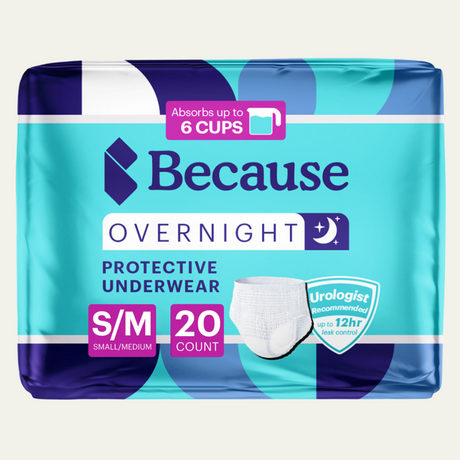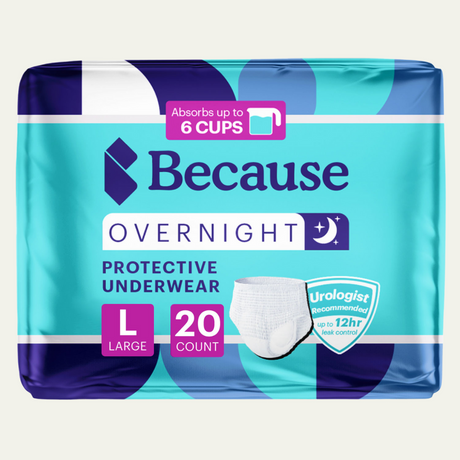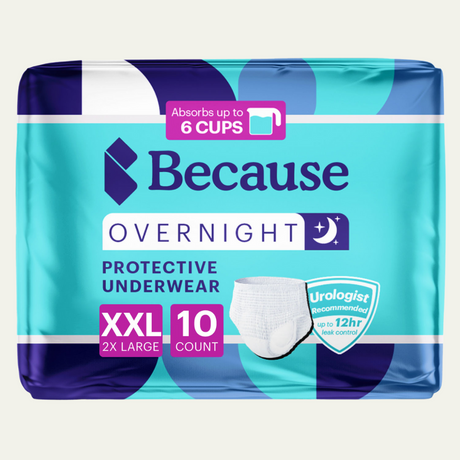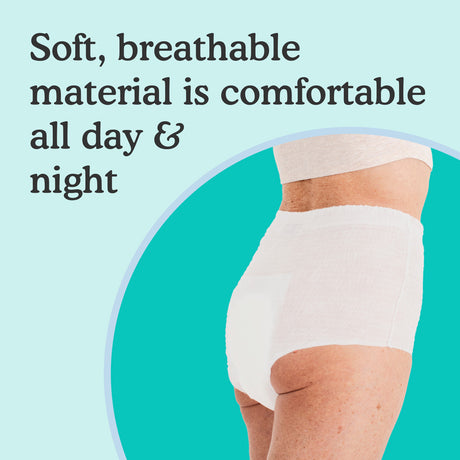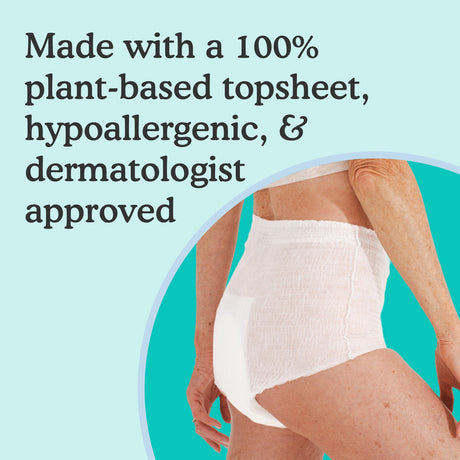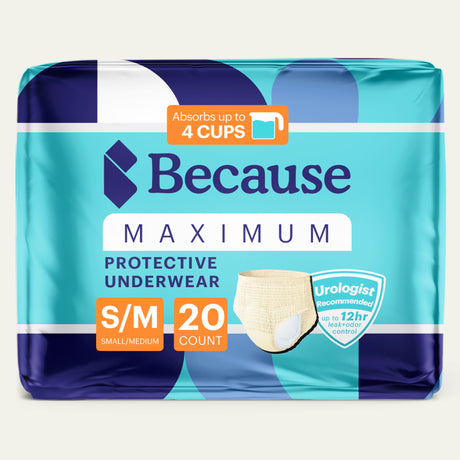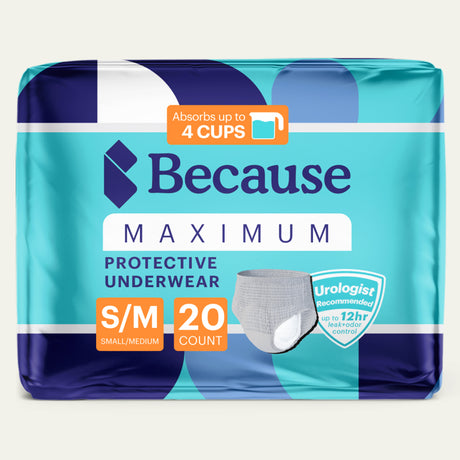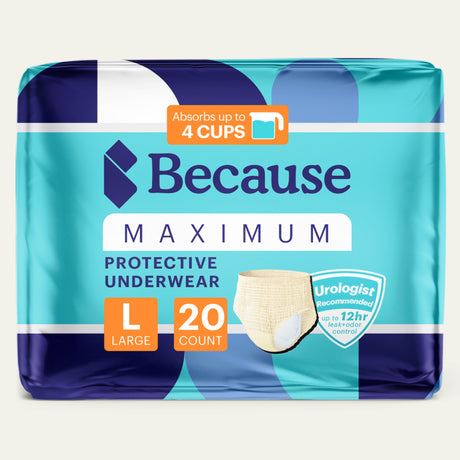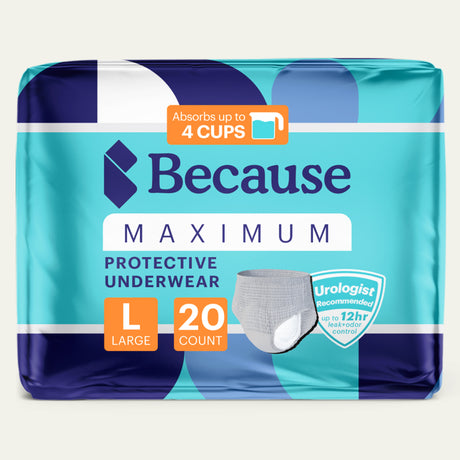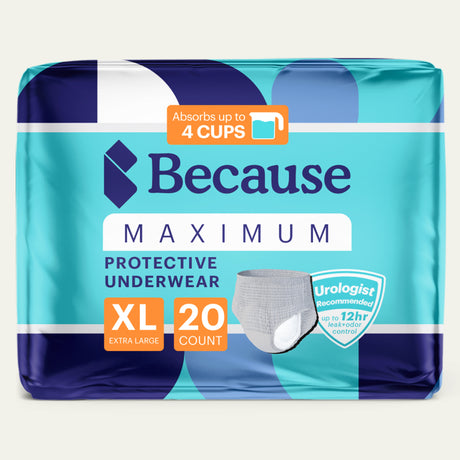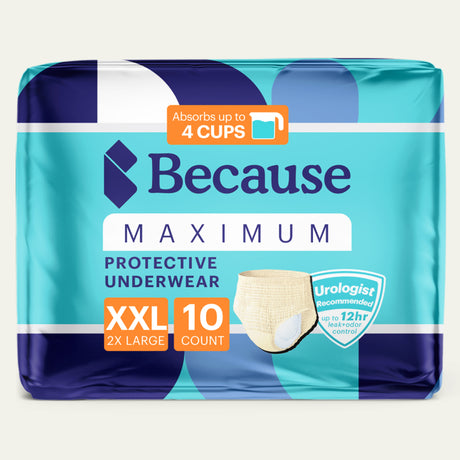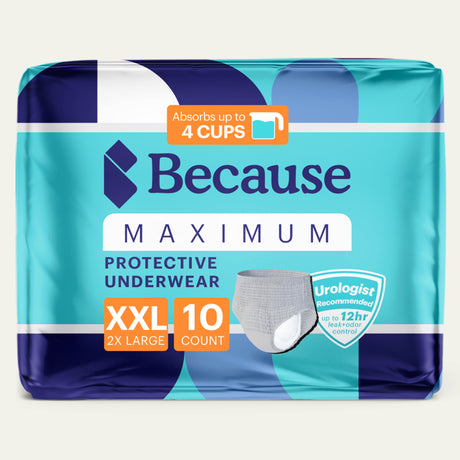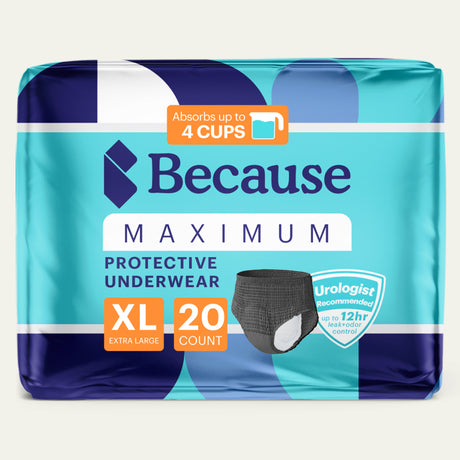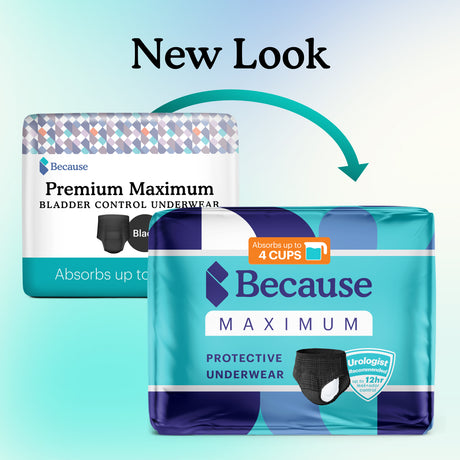More than 25 million people in the U.S. deal with symptoms of urinary incontinence — like bladder leaks and urinary urgency. Medical treatments and lifestyle changes can help manage symptoms, and incontinence pads are great options for bladder protection. We'll delve into what incontinence pads are, how they work, and what characteristics to look for when choosing products.
What Is an Incontinence Pad?

An incontinence pad is an absorbent product worn inside regular underwear to protect against urine leakage. These look similar to menstrual pads that women wear during their periods. However, incontinence protection is designed specifically for capturing urine, making them a better choice than sanitary pads.
What Is an Incontinence Pad Made Of?
Companies that design incontinence pads may use different materials in their products. Generally, most incontinence panty liners and pads are made of absorbent woven fabric and super-absorbent polymer resin or gel. The soft face of the pad is mounted on a waterproof backing made of plastic or similar material, and an adhesive strip is added to the back to hold the pad in place inside undergarments.
How Do Incontinence Pads Work?
The absorbent fabric and polymers are what allow incontinence pads to work. When a urine leak occurs, the fabric top sheet becomes saturated. Then, the polymers in the pad's core quickly draw in the fluid and lock it away. Because the plastic backing is waterproof, the urine can't soak through to the underwear below, and the fabric's outer layer begins to dry quickly. This function helps the pad feel drier against the skin for increased comfort. After an accident, the pad should be removed from the underwear and replaced with a fresh one.
Some individuals wear incontinence pads throughout the day. Others wear them only when they are most at risk for leaks, such as exercising or sleeping at night. Incontinence pads aren't just for men and women with chronic medical conditions. You might need them only for a short time, such as after surgery while recovering from a urinary tract infection or until medication for an overactive bladder or another condition begins to work.
How Much Urine Can an Incontinence Pad Hold?

How much urine bladder pads can hold varies based on the product. The most absorbent incontinence pads available from Because Market can hold up to 3 cups of liquid. Before buying any new urinary incontinence product, you should carefully read the product information to determine its maximum absorbency.
Understanding Key Features of Incontinence Pads
Comparing adult incontinence products becomes easier when you know what features to compare. The following are some of the ways incontinence pads from popular brands differ.
Absorbency Level
As mentioned above, the absorbency level of bladder protection pads differs, but most manufacturers offer multiple absorbency levels to meet different needs and may use other terms to refer to the amount of protection. In our online store, you'll find products with three levels of absorbency for women: moderate, maximum, and overnight. Our men's guards come in one level of protection. Healthcare professionals familiar with your symptoms can help determine how much urine you're likely to pass during an accident.
Adhesive Backing
Incontinence pads can't provide adequate protection if they slip out of place or bunch up inside your underwear. That's why some manufacturers, including Because Market, add adhesive strips to their absorbent pads. The high-quality adhesive acts as an anchor, securing the pads to the fabric of your undergarments. Not only does this reduce the likelihood of leaks, but it also allows the pad to conform better to the contours of the human body for a more comfortable fit.
Leg Guards
To fit inside undergarments properly, bladder protection pads usually have an hourglass shape. With a conventional pad, the edges are the same height as the absorbent face. When leakage occurs, the fluid doesn't just travel downward. It also spreads outward. With regular pads, this can mean urine escapes along the edges.
Leg guards provide a solution to this problem. These raised ridges that run along the edges of the pads paired with leg guards help capture urine as it travels outward, reducing the risk of leaks.
Odor Control
Incontinence can lead to embarrassing body odor, but some pads have features to address this problem. These products usually contain gels that are capable of neutralizing odor. Choosing one of these pads and practicing good incontinence skin care and personal hygiene can go a long way toward promoting fresher skin.
Male vs. Female Design
While you can find unisex pads, most adult incontinence products are intended for men or women. The main difference between the products is the location of the absorbent materials. Male incontinence guards usually have more absorbent material layered in the front, while women's products are positioned more toward the center.
Range of Lengths
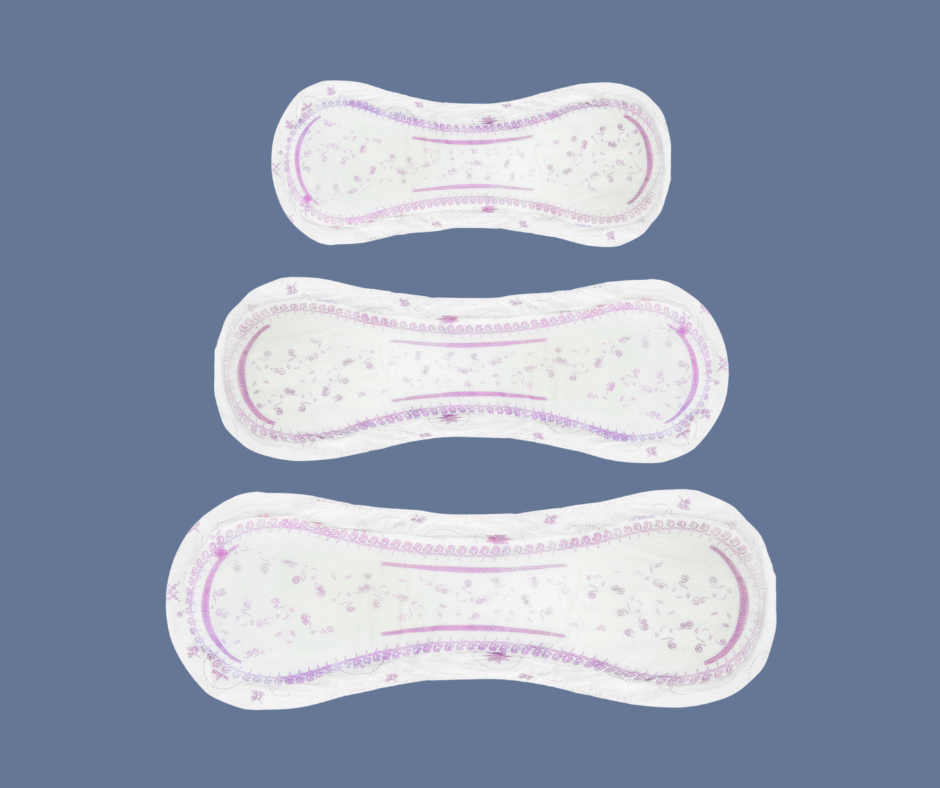
The lengths of incontinence pads vary from product to product. Generally, the higher the absorbency level, the longer the pad will be. Pads with an extended length offer more protection in the front and back to reduce the risk of leaks. This feature is critical with overnight protection, as sleeping in different positions could cause urine to pool in other areas than sitting, standing, or walking.
Range of Thicknesses
The absorbency of a product partially determines its thickness. This factor is because more material is generally needed to absorb larger amounts of liquid. Generally, panty liners are the thinnest option. These products can hold only small amounts of urine and are best for mild, occasional leaks. Some manufacturers have made advancements in design that allow even maximum absorbency pads to be surprisingly thin. This eliminates the bulky fit that can make other pads less comfortable and discreet.
Types of Incontinence Pads and How to Choose

Because Market offers a diverse selection of incontinence pads for men and women. When deciding which type is right for you, consider:
- Type of incontinence: Some male guards and absorbent pads are better suited for those with certain types of incontinence. For example, stress incontinence may only cause occasional leaks during the day, making a moderately absorbent pad in a regular length a good choice.
- Personal preference: Think about what makes you feel most confident and comfortable. For example, the additional protection of a long length may allow you to worry less about leaks.
- Characteristics of symptoms: Considering your symptoms can help you choose the right product. When do you experience leaks or accidents? How frequently do they occur? Is there any variability in your symptoms, or do you usually experience light, moderate, or heavy leakage?
- Your lifestyle: Promptly changing and disposing of used bladder control pads is essential for protecting your skin and controlling odors. However, those with busy, on-the-go lives or who travel frequently may not always have the luxury of being near a bathroom for changes. If this sounds familiar, choosing pads or shields with a higher level of absorbency may be a better choice for you.
- Your skin: If you're prone to skin irritation, look for products made of skin-safe materials less likely to trigger allergies and sensitivity reactions. Because Market simplifies shopping for skin-friendly incontinence protection, all of the products you'll find on our site are designed with sensitive skin needs in mind.
Remembering these considerations as you continue reading about the various types of Because Market products can help you choose the best incontinence pads or guards for your needs.
Because Premium Pads for Women (Moderate)
Our Because Premium Pads for Women have moderate protection that can absorb 1 cup or 8 ounces of urine. They boast an odor-fighting gel absorption layer and leg guards to keep you fresher while lowering the likelihood of leaks. Measuring 11 inches, they’re the shortest length available in our range of products for women.
Because Premium Pads for Women (Maximum)
Our Because Premium Pads for Women with maximum absorbency provide extra protection. They hold up to 2 cups of liquid and have an overall 12-inch length. Like the moderate pads, these incontinence products have an absorbent gel core and leg guards. Although they’re slightly thicker, they still have an ergonomic design that reduces bulk for an enhanced fit.
Because Premium Pads for Women (Overnight)
Capable of holding up to 3 cups of urine, the Because Premium Pads for Women are an ideal overnight pad because they offer the highest level of absorbency. The 14-inch pads are 2 inches longer than the maximum option while providing the same leak and odor protection with a gel core and leg guards. Despite their high level of absorbency, they’re ergonomically engineered for a bulk-free fit.
Because Premium Guards for Men (Maximum)

We offer guards that can hold more than 2 cups of urine for men. Like our women's incontinence pads, the Because Premium Guards for Men provide the confidence boost of leg guards and odor-controlling gel but with ergonomics to fit a man's body. The men's guards are 12 inches long and feature strong adhesive backings, just like our female incontinence products.
Because Premium Booster Pads

The Because Premium Boost Pads look similar to an ordinary incontinence pads but serve a different purpose. Instead of being worn inside standard undergarments, these products are paired with protective underwear to boost absorbency. As a result, they don't have the waterproof backing found on our conventional bladder pads. Once the incontinence pads become soaked, urine flows to the incontinence pads, which absorb the liquid. Adding booster pads increases the absorbency of adult briefs for incontinence by an extra 4 cups.
Other Types of Incontinence Products to Consider
Female and male incontinence pads are just one way to manage incontinence symptoms. Depending on your needs, you may use one of the following hygiene products along with or instead of urinary incontinence pads.
Because Premium Bladder Control Underwear
Our Because Premium Bladder Control Underwear are pull-ons that you wear in place of conventional undergarments. Although these types of protection are referred to as adult diapers, our briefs are made of soft, breathable fabric that is ergonomically engineered and enhanced with stretch. This feature enables them to look and feel as much like ordinary underwear as possible. We offer protective underwear for men and women in an assortment of sizes and absorbency levels.
Some individuals may prefer the simplicity of bladder control underwear or want the added protection provided by pairing incontinence adult briefs with booster pads. Those with bowel incontinence often benefit from the added coverage of incontinence underwear.
Because Premium Bed Protectors

Our Because Premium Bed Protectors are soft, absorbent sheets with a waterproof backing you can place on beds, sofas, or car seats to provide an extra layer of protection. Because they're disposable, they're a convenient way to deal with leaks. Some individuals use them nightly in bed or occasionally to deal with alcohol incontinence. They also come in handy for work, air travel, bus trips, car trips, performances, and other times when you may not be able to change your incontinence protection as often as you'd like.
Do you or a loved one struggle with incontinence? Take our bladder protection quiz and get a sample pack to try.
If you're struggling with incontinence, join one of our private support groups today!
Women's Incontinence Support Group
Men's Incontinence Support Group
Source:
Johns Hopkins Medicine. (n.d.). Urinary Incontinence in Women. https://www.hopkinsmedicine.org/health/conditions-and-diseases/urinary-incontinence/urinary-incontinence-in-women


